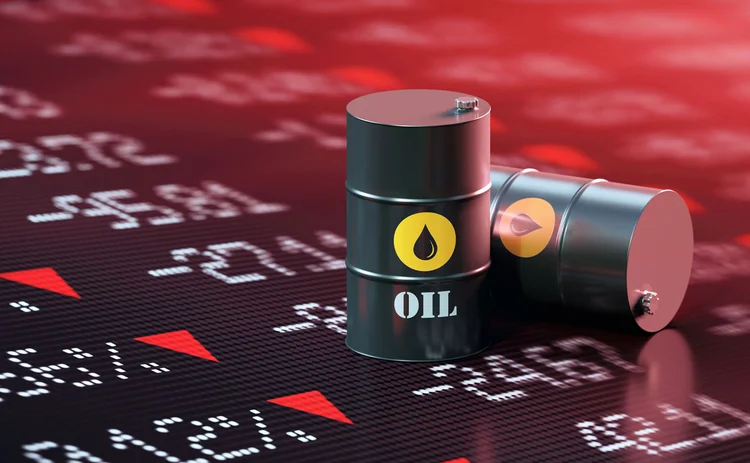
Negative oil prices put spotlight on investors
What part did Bank of China and other investors play in last month’s oil rout, asks derivatives veteran

Oil’s historic plunge into negative prices last month raises vital questions about both the role of investor products in commodities and the functioning of futures markets around expiry. One thing is for sure, while Covid-19 has caused an unprecedented oil demand shock, it does not account for the 300% drop in the price of US benchmark crude on April 20, much of which took place in just 20 minutes.
Having closed at $18.27 a barrel (/bbl) on Friday April 17, West Texas Intermediate crude futures for May delivery traded on the CME had plummeted to zero by 14:08 EST the following trading day. This was the penultimate day of the contract. In the following 20 minutes, prices slid a further $40/bbl into negative territory before settling at a historic -$37.63/bbl (see table A). During this time, there was no material change in physical storage. Furthermore, shortly after 20:00 EST, the contract bounced back into positive territory, expiring the following day at $10.01/bbl, a level much more reflective of physical market economics.
Coming into its final trading days, the May WTI contract had already made headlines by setting record contango levels as the May/June spread blew out to -$7/bbl. This reflected the state of the physical market, where storage at Cushing, Oklahoma, the delivery point for the WTI contract, was becoming full. However, on April 20, the May/June spread blew out to minus $60/bbl during the settlement window, before narrowing just a few hours later to around -$21/bbl and then expiring the next day at -$1.56. All the while physical storage remained virtually unchanged.
It is notable that the day before futures expiry can often be volatile due to the expiry of calendar spread options and the settlement of various over-the-counter derivatives products. This is why most investor products such as exchange-traded-funds (ETFs) roll their positions much earlier in the month. On April 20, open interest in the May contract – at 108,593 contracts – was fairly large. However, a closer look reveals open interest in put options on the May/June spread, known as synthetic storage, was equally large at 63,550. This means many puts were so deep in-the-money that options were effectively offsetting futures one-for-one. With these options converting into futures at settlement prices and netting against outstanding futures positions, large physical traders did not have to trade much at all.
Likewise, banks carried some short futures as hedges against ratably settled OTC swaps and options they traded with producers. CME’s trading at settlement (TAS) mechanism allows OTC dealers to execute futures in advance at prices that will be determined later at settlement, offsetting dealers’ bilateral exposure. Usually the TAS market is fairly balanced between sellers and buyers. May, however, was an exception. Big players had already left the contract and TAS became offered at larger and larger discounts to the settlement price throughout the day.
Increasingly desperate sellers pushed the discount out until it reached its maximum daily limit soon after 14:00 EST and was closed by CME. Reaching this limit – set at 10 cents – was unprecedented for TAS, which ordinarily trades at a maximum of 1 or 2 cents above or below settlement.
Figures on the exact losses have not yet been disclosed and estimates range from $85 million up to a billion dollars
This limit signalled a huge liquidity gap and growing panic among the few remaining traders, because whatever long positions could not be liquidated using TAS now had to be quickly sold in the open market. That day, 77,076 contracts traded in TAS. In contrast, it was a very small number of contracts – closer to 10,000 lots or ten million barrels of oil – that got caught in the bloodbath of the open market, illustrating clearly how relatively small positions can wreak havoc.
One of the biggest participants remaining was Bank of China (BoC). The state-owned bank’s retail investor product, Yuan You Bao – crude oil treasure – still held positions for thousands of investors at the start of that day and, as prices plunged into negative territory, went on to rack up massive losses.
Figures on the exact losses have not yet been disclosed and estimates range from $85 million up to a billion dollars. The lower end of this range would appear more plausible though and goes to show how much a large US market can be moved with relatively small volumes, especially when they are driven by obscure structured products that fall outside of US regulations.

Questions now need to be asked about why the Yuan You Bao product allowed investors to remain in the market right up to the penultimate day of the contract, thereby exposing them to high levels of volatility and potential risk. Additionally it would be good to understand why the bank appeared to be enticing more investors into its product even as prices were firmly on the slide, running an advert (see right) describing oil as “cheaper than water”.
The investment product itself appeared to be insulated from this risk due to the fact that customers had to prepay the entire notional amount of futures when opening the account. As long as futures prices stayed positive, keeping this notional amount as collateral would be safe. However, as soon as prices went into negative, it was not enough.
Given the lack of sophistication among many retail investors, BoC had prudently inserted an important risk mitigation clause into its policy, allowing it to liquidate the client’s position if the account balance dropped below 20% of the notional amount. In other words, the bank had the right, but not the obligation, to liquidate futures on behalf of clients.
Additionally, customers were not allowed to place any orders after 10:00 EST (22:00 Beijing time) on the penultimate day. This gave Bank of China traders an embedded optionality for four and half hours between 10:00 EST and 14:30 EST when WTI on the CME settles.
Why didn’t they use this to terminate their investors’ accounts earlier when the balance fell below the contractual threshold? If we set aside for a moment any rules of ethics or the dealer’s fiduciary responsibilities, then the most rational decision at 10:00 EST for the market-maker would be to do nothing and perhaps attempt to monetise this option rather than intervening and dealing with potentially unhappy customers. Since futures prices at the time were already very low, it was not unreasonable to expect some short-term bounce.
If prices had returned to $20/bbl and traders had terminated their clients’ positions earlier at lower prices, they would undoubtedly have had many complaints. Doing nothing was also possibly easier from a legal perspective as, if the price continued to slide, the positions would just settle or roll at 14:30 EST as specified in the contract. In this case, the dealer’s embedded option would expire worthless and the customer would pay for the loss.
We may, of course, never know the whole truth about why BoC did not use its contractual right to liquidate the trades earlier, when clients’ accounts were already drained. Regulators will need to satisfy themselves as to the motives behind the behaviour that led to such painful losses that day.
Given the lack of sophistication among many retail investors, BoC had prudently inserted an important risk mitigation clause into its policy, allowing it to liquidate the client’s position if the account balance dropped below 20% of the notional amount
What it has done is expose a vulnerability in the system at a time of crisis. The fact that negative oil prices – once considered unfeasible – are now a real possibility, has turned traditional assumptions about risk in the oil market on their head, shattering investor confidence and creating yet more woes for the embattled US shale industry.
While the BoC position provides a salutary lesson in the pitfalls of holding positions at expiry, all long-only investor products hold a degree of risk – possibly not widely understood – when markets are in contango. Here, it is worth considering the function that speculators play and their role in facilitating the physical functioning of the market.
Any attempt to disentangle physical oil markets from financial derivatives and analyse them independently remains largely wishful thinking. One cannot exist without another, and the two markets are strongly intertwined. From the early days of commodity futures trading, the business of storing provided the much-needed linkage. The economic function of storage is to link the present and future allocation of resources. The way this is done in practice is via the “carry trade”, when the owner of physical storage – either a storage operator or a large oil trader that is leasing storage – buys a barrel of oil in the spot market and sells futures as a hedge to cover the cost of storage.
On the other side of the trade is usually a speculator or investor wanting exposure to oil but not wanting physical ownership because storing oil is a costly and cumbersome business. Purchasing futures, or investing in a long-only ETF – which is pretty much the same thing – is the closest approximation to a direct oil purchase.
When a roll takes place in a backwardated market, funds benefit from a positive roll yield, selling out expiring positions at a higher price than they pay to buy the positions in the following month’s contract. But when the market is in contango, investors pay to roll the contracts.
Over the past decade, this negative roll yield has been catastrophic. While the spot price of WTI is currently close to the level it was 10 years ago, buying and rolling futures would have cost investors almost $100/bbl over the past decade even prior to extreme moves in April.
The roll is essentially the remuneration to the storage owner for providing investors with the service of storing. Conceptually, the negative roll acts as a fee that the investor is willing to pay for the privilege of investing in oil. The larger the cost of storage, the larger the fee.
Participants in investor products such as oil ETFs are often fooled by an optical illusion that is magnified when oil prices reach extremes. When demand drops and prices fall, the price of storage will rise and the market will go into a deeper contango at the front end. Longer-dated prices tend to remain higher because they are less affected by near-term demand and more driven by the marginal costs of production.
The result is that whenever prices drop and it appears like the best time to buy, the fee that the buyer will indirectly pay via the negative roll becomes increasingly punitive. For example, if the front contract trades at $25/bbl and the second contract is at $30/bbl, then one effectively is willing to pay $5/bbl or 20% of the initial investment per month just for the opportunity to play the futures game. With such a large entry cost, it is becoming increasingly difficult for ETF or futures investors to win in the long run.
Such investor products, however, generate lucrative commissions for their designers. The optical illusion of buying something cheap makes it an easy product to sell especially to less sophisticated retail investors.
Participants in investor products such as oil ETFs are often fooled by an optical illusion that is magnified when oil prices reach extremes. When demand drops and prices fall, the price of storage will rise and the market will go into a deeper contango at the front end
This is why investor funds need to be watched closely as they become a bigger part of the market. Even though it rolls earlier in the month and so avoids thin trade around expiry, the United States Oil (USO) fund has a futures position that is around 100 times larger than the Bao positions were that day. At one point it had reportedly acquired some 25% of open interest in the May WTI contract.
How is USO performing? Exactly how you would expect an investment in a storable commodity to perform when storage capacity is limited and therefore more expensive: down 82% year-to-date. However, client inflows are at record levels. The optical illusion continues as the crowd is still willing to pay high premiums for the privilege to play this game.
Ilia Bouchouev is former president of Koch Global Partners, where he managed the energy and financial derivatives trading business for more than 20 years. He is currently managing partner of Pentathlon Investments. e-mail: ib@pentinv.com
Only users who have a paid subscription or are part of a corporate subscription are able to print or copy content.
To access these options, along with all other subscription benefits, please contact info@risk.net or view our subscription options here: http://subscriptions.risk.net/subscribe
You are currently unable to print this content. Please contact info@risk.net to find out more.
You are currently unable to copy this content. Please contact info@risk.net to find out more.
Copyright Infopro Digital Limited. All rights reserved.
As outlined in our terms and conditions, https://www.infopro-digital.com/terms-and-conditions/subscriptions/ (point 2.4), printing is limited to a single copy.
If you would like to purchase additional rights please email info@risk.net
Copyright Infopro Digital Limited. All rights reserved.
You may share this content using our article tools. As outlined in our terms and conditions, https://www.infopro-digital.com/terms-and-conditions/subscriptions/ (clause 2.4), an Authorised User may only make one copy of the materials for their own personal use. You must also comply with the restrictions in clause 2.5.
If you would like to purchase additional rights please email info@risk.net
More on Comment
Responsible AI is about payoffs as much as principles
How one firm cut loan processing times and improved fraud detection without compromising on governance
Op risk data: Low latency, high cost for NSE
Also: Brahmbhatt fraud hits BlackRock, JP Morgan slow to shop dubious deals. Data by ORX News
Quantcast Master’s Series: Kihun Nam, Monash University
Melbourne-based programme winks at pension fund sector
How Basel III endgame will reshape banks’ business mix
B3E will affect portfolio focus and client strategy, says capital risk strategist
Why source code access is critical to Dora compliance
As Dora takes hold in EU, access to source code is increasingly essential, says Adaptive’s Kevin Covington
Quantcast Master’s Series: Petter Kolm, Courant Institute
The NYU programme is taught almost exclusively by elite financial industry practitioners
CVA capital charges – the gorilla in the mist
The behaviour of CVA risk weights at US banks in 2020 hints at the impact of the Basel III endgame
NMRF framework: does it satisfy the ‘use test’?
Non-modellable risk factors affect risk sensitivity and face practical and calibration difficulties, argue two risk experts







